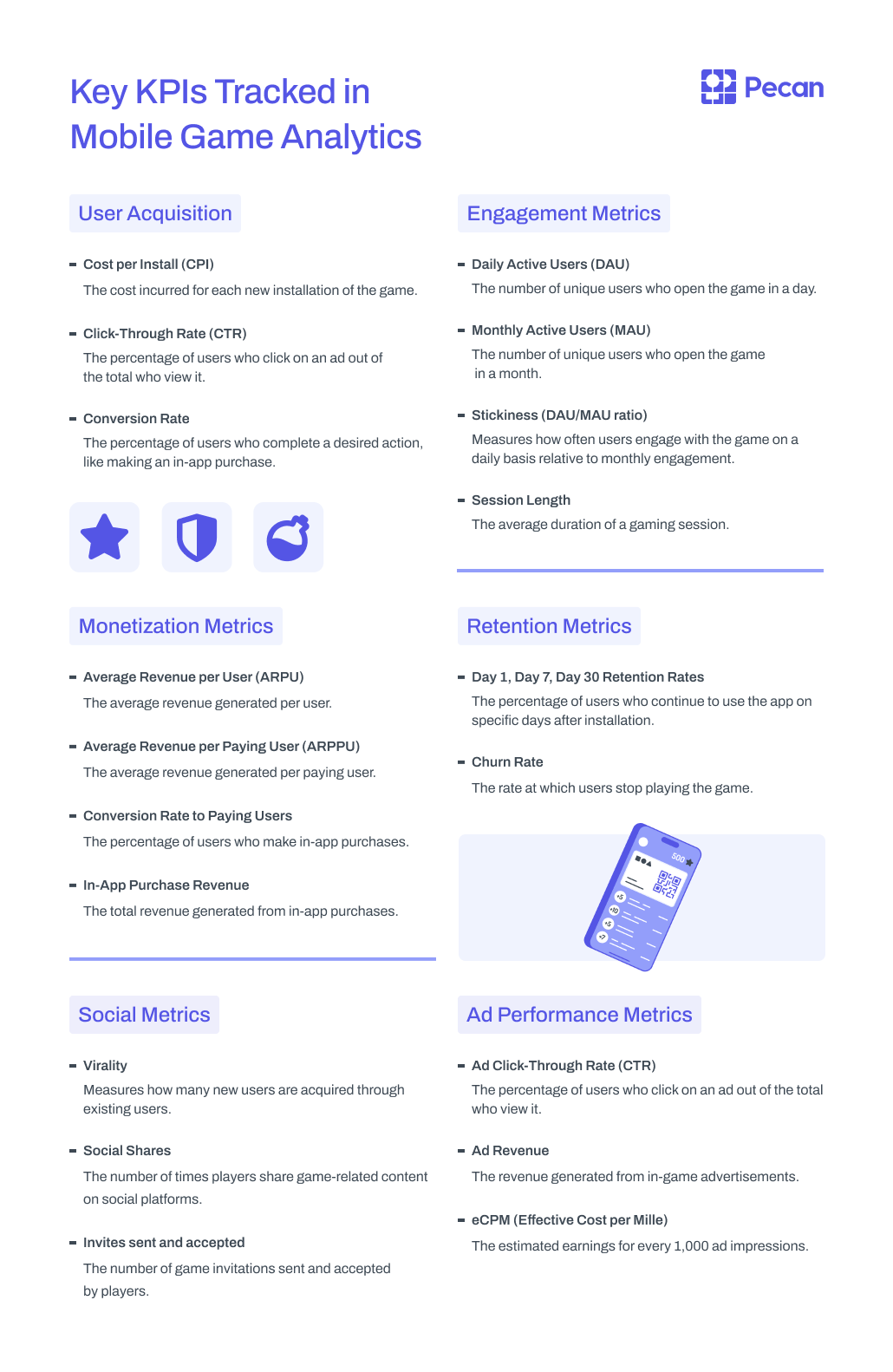In a nutshell:
- Mobile game analytics uses historical data to understand user behavior, make decisions about user acquisition and experience, and plan short- and long-term strategy.
- The large amount of data collected by many developers makes it difficult to take action on a wide range of KPIs.
- Predictive analytics is increasingly being used by mobile gaming companies to guide marketing strategy, product development, and resource allocation.
- It helps in boosting in-game purchases, player retention, and the lifetime value of players.
- Pecan's predictive analytics platform helps game makers optimize user acquisition, improve monetization, reduce churn, and cross-promote other apps.
According to data from Statista, the global mobile gaming industry will have a market value of more than $118 billion by 2027. With such success comes a need to carefully track games' performance and the key metrics involved in ensuring their success. Investing in mobile game analytics has become more critical than ever in this exciting environment.
For mobile game marketers, especially, deeply understanding what attracts new players and helps them stick around is an invaluable guide to decision-making and long-term strategy.
But while understanding what happened in the past in your mobile game marketing is important, you might be missing out on a key benefit of having all that data. In short, you can use your vast data collection from marketing and user activities to see into the future. Predictive analytics can help you anticipate the return on ad spend of your ad campaigns, foresee users' lifetime value, predict potential user churn, and much more.
Let's explore how mobile game analytics usually work — and then take a look at the new opportunities that AI enables for your team.
Which metrics are typically tracked in effective mobile game analytics?
Diligent mobile app marketers are constantly collecting data that allows them to track many KPIs.
-

- The key KPIs tracked in mobile game analytics
That's a lot of KPIs! And most of these data points are tracked using historical data — looking back at past user activity and transactions to understand a game's success.
Tracking everything on that long list can be overwhelming. Traditional mobile gaming analytics can fail to deliver actionable insights for developers. However, it's essential to recognize the potential of these analytics tools when used strategically.
Advanced analytics platforms can sift through this data to uncover valuable patterns. With proper implementation and focused analysis, developers can gain meaningful insights into user behavior, engagement, and monetization, leading to informed decisions.
The key is effectively leveraging analytics tools, focusing on relevant KPIs, and employing data-driven strategies to enhance the gaming experience and optimize performance.
-

- Photo by Andrey Matveev on Unsplash
The next step beyond mobile game analytics
As the industry grows in size and value, mobile gaming companies are increasingly turning to a technique known as predictive analytics. This technical tool can be used to guide marketing strategy and campaigns, product development, resource allocation, and other business decisions. Predictive analytics can also help mobile gaming companies with specific business goals, such as increasing in-game purchases, player retention, and the lifetime value of the average player.
Predictive analytics uses sophisticated algorithms and mathematical models to predict possible outcomes based on past events. Businesses collect valuable data, use predictive analytics to extrapolate the most likely outcomes and make decisions based on these highly informed predictions.
In the mobile gaming industry, companies will often apply predictive analytics to customer data, which, in this case, equates to player data. Valuable data includes app installation and retention information, in-app activities, in-app incentives, app ad monetization, and in-app purchases.
Predictions from analytics models are used to create customer profiles, which are then used to determine which users are most likely to install an app, churn, make in-game purchases, or be high-value players. Companies can then target specific digital products and services based on customer profiles. Analytics is also used to design new games and boost revenue for the game developer.
Through predictive analytics, gaming companies are better able to provide customers with exactly what they are looking for. That means they can reduce player churn, grow player LTV, and potentially increase revenue by retaining more players.
-

- Photo by Andrey Matveev on Unsplash
Mobile Game Analytics in the SKAN Era
Traditional game analytics are also becoming insufficient due to changes in the larger app ecosystem, making predictive analytics even more helpful.
In particular, mobile app developers are turning to predictive analytics to navigate Apple's SKAdNetwork for several reasons:
- Limited Data Attribution: SKAdNetwork, introduced by Apple for privacy reasons, provides limited data on ad attribution, making it challenging for developers to track and measure the effectiveness of their advertising campaigns.
- Conversion Value Challenges: SKAdNetwork's model relies on conversion values, but the limited number of available values (63 in total) makes it difficult for developers to accurately capture the nuances of user behavior and attribute conversions.
- Predictive Modeling for Optimization: Predictive analytics enables developers to create models that predict user behavior and conversion outcomes. By leveraging historical data and user patterns, developers can optimize their ad spending and target audiences more effectively within the constraints of SKAdNetwork.
- Enhanced Decision-Making: Predictive analytics provides developers with insights into user engagement, allowing them to make informed decisions about campaign adjustments, creative optimization, and budget allocation based on anticipated outcomes rather than relying solely on SKAdNetwork's limited data.
- Long-Term Strategy Planning: Predictive analytics provides a more comprehensive and forward-looking approach to marketing strategies. Developers can anticipate trends, understand user lifetime value, and plan for the long term, mitigating the impact of SKAdNetwork's constraints on immediate, short-term insights.
- Optimizing Limited Signals: Since SKAdNetwork provides sparse data signals, predictive analytics helps fill the gaps by extrapolating from the available data to make more accurate predictions about user behavior, enabling developers to fine-tune their strategies.
Predictive analytics serves as a strategic tool for mobile app developers navigating Apple's SKAdNetwork limitations. It provides them with the means to derive actionable insights, optimize ad campaigns, and make informed decisions in the absence of detailed attribution data.
Reducing Churn in Mobile Gaming
Analytics is an especially invaluable tool for fighting churn. As long as businesses have been around, customer retention has been an important focus.
Gaming companies’ recruitment of predictive analytics in the battle against customer churn is just its latest evolution. Our experience at Pecan has shown that predictive analytics is a very effective way to extend the length of a customer relationship and identify the risk of turnover for certain types of customers.
People stop playing mobile games for different reasons. A study performed by Clutch found that 33 percent of app users get frustrated when the onboarding process takes more than two minutes. Users onboarded effectively can have an increased lifetime value of more than 500 percent.
Other game components or the player experience could also contribute to churn. If a gaming company can intervene before someone decides to stop using the app, it can address concerns, improving retention and player LTV.
Why Predictive Analytics Is Becoming More Popular in Mobile Gaming
If users like an app enough, they will spend money on it and in it. Many mobile games now generate revenue through game passes, subscriptions, and other in-game purchases.
If a game maker knew how each potential user was going to interact with their app, the company could specifically customize offerings to attract user spending. However, accurately predicting how someone would use various app functions and offerings has been difficult until now.
Rather than focusing on users’ purchase amounts or progression events during their first interactions with the app, developers can use predictive events based on their wealth of historical in-app data to gain significant insight into the future value of a user-acquisition campaign. Using predictive analytics, developers can better anticipate how much users will spend by the 30-day mark.
Importantly, these metrics can also be used to minimize churn. When applied to churn statistics, game analytics software can identify pain points, such as a poor onboarding experience or lack of personalization. Companies can then address issues quickly before they become widespread issues that alienate more users.
It is important to note that predictive analytics describes how likely it is that an event, like churn, will happen. Developers looking to leverage the power of predictive analytics should select a churn prediction solution created by experts in the field. It’s also important for the solution to be thoroughly tried and tested to ensure it produces reliable, accurate, explainable predictions.
-

- Photo by Jakub Żerdzicki on Unsplash
Case study: Using mobile game analytics with predictions for retargeting
Imagine running a popular mobile game with millions of players worldwide, and you're trying to figure out who needs a little push to return to the game. SciPlay, a leading mobile entertainment provider, faced this challenge despite having a solid retargeting campaign. They realized not all players needed targeted campaigns, so they turned to Pecan's predictive analytics to streamline the process.
With Pecan's tech, SciPlay now efficiently identifies the right players for optimizing retargeting, saving millions annually. Instead of relying on traditional business rules, they use machine learning models to pinpoint players who might need that extra nudge, allowing for better-targeted ads and offers. Pecan's predictions have significantly improved ROI and marketing efficiency, enabling SciPlay to invest budgets wisely and accurately measure real revenue impact.
The flexibility of Pecan's platform has empowered SciPlay to react faster, saving money, increasing efficiency, and enhancing the user experience.
Common concerns about predictive analytics in mobile game analytics
Q: Can mobile game analytics accurately predict player behavior?
A: While not always 100% accurate, mobile game analytics provide valuable insights and trends that can significantly inform decision-making and improve overall game performance. These analytics can help identify patterns in player engagement, retention rates, and in-game purchases. By analyzing this data, developers can make informed decisions about game design, content updates, and monetization strategies, leading to a better player experience and increased revenue.
Q: Is there a risk of analytics oversaturation in the mobile gaming industry?
A: The key to success is using analytics strategically and selectively. By targeting specific areas where data-driven insights can have the greatest impact, developers can avoid oversaturation and maximize the benefits of analytics. For example, focusing on key performance indicators (KPIs) such as daily active users, average revenue per user, and player lifetime value can provide actionable insights without overwhelming the development team with excess data. This targeted approach ensures that analytics remain a valuable tool rather than a burden.
Q: Are predictive mobile game analytics effective for all types of gaming apps?
A: Mobile game analytics can provide valuable predictions for a wide range of games. When tailored to the specific goals and objectives of each game, they can be highly effective in improving various aspects of game design and performance. For casual games, analytics might focus on session length and frequency, while for strategy games, they might emphasize player progression and in-game economy balance. By customizing analytics to fit the game's genre and target audience, developers can extract meaningful data that drives improvement across different game types.
Q: Is implementing predictive elements in mobile game analytics cost-effective?
A: While there may be initial costs, the potential benefits of mobile game analytics far outweigh the investment. These benefits include optimizing player experience, enhancing monetization strategies, and improving marketing efforts, all of which can lead to increased revenue and player satisfaction. For example, predictive analytics can help identify the most effective user acquisition channels, optimize in-game purchase offerings, and fine-tune difficulty levels to keep players engaged. Over time, these data-driven improvements can significantly boost player retention and monetization, resulting in a strong return on investment.
Engaging and Retaining Users with Pecan
Analytics is crucial for creating engaging mobile games, adapting to player preferences, and optimizing gameplay experiences. But predictive analytics can level up your marketing and user acquisition strategies.
Predictive analytics from Pecan allows game makers to predict every phase of the user journey. Our technology helps gaming companies optimize user acquisition, improve monetization, reduce churn, and cross-promote other apps.
Our predictive analytics platform is straightforward to use. Add your data sources, and the platform automatically performs data prep and feature engineering. Our platform also optimizes and trains its predictive models to quickly generate accurate insights, as well as continuously monitoring models to maintain accurate results over time.
Want to learn more about our cutting-edge technology and how it can help game developed go beyond the basics of mobile game analytics? Contact us today.




